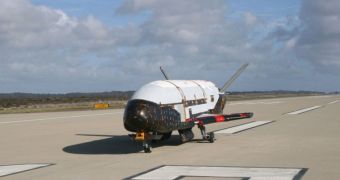With the new buzz circling the Internet about the secretive X-37B space plane belonging to the US Air Force, interest in the spacecraft has been boosted to new heights. Some specialists are beginning to wonder whether a robot of this type is actually needed or not.
The secretive nature of the X-37B project has fascinated many since its inception, in the 2000s. Originally owned by NASA, the space plane was then handed over to the Pentagon, and put under the command of the US Defense Advanced Research Projects Agency (DARPA).
What military officials were fascinated by was the spacecraft's ability to carry out mission in low-Earth (LEO) orbit on its own, carry a large variety of payloads within its cargo limits, and spend several months in space.
In fact, the X-37B currently in LEO has been there since April 22, 2010, when it was launched to space from the Cape Canaveral Air Force Station (CCAFS), in Florida, atop an Atlas V delivery system.
One group that sees no point in the existence of such a robotic plane is the Union of Concerned Scientists (UCS), a group that has already urged Obama and Congress to conduct a review of the American space plane program.
“It isn't everything to everyone. It's actually quite limited,” says UCS Washington physicist and space security expert Laura Grego. Her group adds that almost all functions the X-37B can carry out can be completed by other spacecraft at lower prices.
But Air Force officials defend their investment, saying that the robot is capable of bringing scientific equipment safely back to work after months of stay in space, something that is impossible with other spacecraft but the space shuttles.
In addition to its limited uses, the UCS says, the craft also represents a threat to peace, since China and Russia have become uneasy when the US launched the robotic plane. These two nations rightfully fear that nuclear weapons could be deployed to orbit.
Grego also says that the platform itself – which was developed by Boeing Phantom Works – cannot be used to deploy military personnel to operations theaters, or to carry missiles and bombs.
But some say that, during recent years, the DOD has been experimenting with more and more systems that do not necessarily have a highly specialized function, but are rather more flexible, capable of undertaking a variety of missions at the same time.
“The X-37B doesn't do one thing really well, but it does a lot of things. So in that sense, I can see the argument for it,” says former USAF orbital analyst Brian Weeden. He believes the possibility of installing weapons on this space platform to be about zero.
“From everything I know about it, it's not that much more advanced than the shuttle. It's evolutionary, not revolutionary, with respect to the shuttle,” he concludes, quoted by Space.

 14 DAY TRIAL //
14 DAY TRIAL //